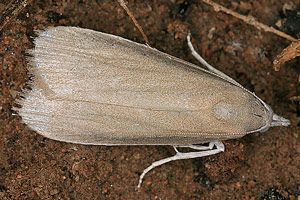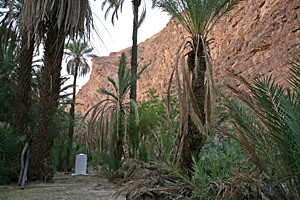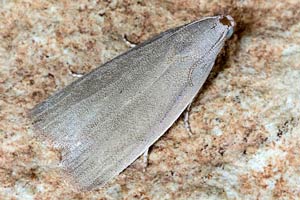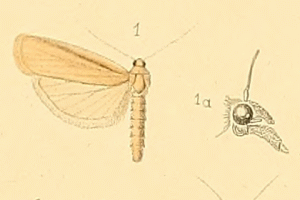1. Lebendfotos
1.1. Falter
2. Diagnose
2.1. Genitalien
2.1.1. Weibchen
2.2. Erstbeschreibung
3. Biologie
3.1. Habitat
3.2. Nahrung der Raupe
- [Arecaceae:] Phoenix dactylifera (Echte Dattelpalme)
In Nordafrika gilt die Art als Schädling an Dattelpalmen (Phoenix dactylifera). Sie frisst nicht nur Blätter und junge Triebe, sondern kann sich auch mit trockenen Dattel-Früchten, trockenen Blättern und auch anderen toten Pflanzenresten und sogar Insekten ernähren.
4. Weitere Informationen
4.1. Andere Kombinationen
- Arenipses sabella Hampson, 1901 [Originalkombination]
4.2. Faunistik
Die Art ist in Nordafrika und im Nahen Osten bodenständig. Asselbergs (1999) meldet die Art als neu für Europa - Fundort Spanien, Alicante: La Marina. Hier ist wohl ebenfalls von Bodenständigkeit auszugehen. Ylla et al. (2015) können für Süd-Spanien 2 neue Funde aus der Provinz Almería ergänzen: "Saladar de Vera, 1 ♀ el 22-IV-2007; Tabernas, 4 ♂♂ el 18-X-2014."
Agassiz et al. (2013: 112) führen die Art bei den "adventive species" und schreiben zu England: "Two, one reared from dates London, 1917, another, probably from dates, Canterbury, Kent early C20. North African/ Middle Eastern."
Aus England sind zwei alte Einschleppungen mit Datteln bekannt (London: 23. Juli 1917; Canterbury: 12. Juli 1918), aus Frankreich eine (Alpes-Maritimes, 22. Mai 2003, in einer Zuchtanlage für 2001 aus Ägypten importierte Dattelpalmen) (Slamka 2006, Leraut 2014).
Falck et al. (2019: 34) melden die Art von Teneriffa und damit als neu für die Kanarischen Inseln.
(Autor: Erwin Rennwald)
4.3. Literatur
- Agassiz, D.J.L., Beavan, S.D. & R.J. Heckford (2013): Checklist of the Lepidoptera of the British Isles. - Royal Entomological Society. 206pp.
- Asselbergs, J. E. F. (1999): Arenipses sabella Hampson, 1901, from South Spain: new to the European fauna; Thylacoptila paurosema Meyrick, 1885, new to the fauna of the Canary Islands; Ancylosis (Ancylosis) albidella Ragonot, 1888, new to the Spanish fauna (Lepidoptera: Pyralidae, Galleriinae, Phycitinae). — SHILAP Revista de Lepidopterología 27 (105): 125-129.
- Falck, P., Karsholt, O. & F. Slamka (2019): New data on Pyraloidea from the Canary Islands, Spain (Lepidoptera: Pyraloidea). — SHILAP Revista de Lepidopterología 47 (185): 33-48. [PDF auf redalyc.org]
- Garre, M., Rubio, R. M., Guerrero, J. J., Girdley, J. & A. S. Ortiz (2018): Adición de Aphomia (Arenipses) sabella (Hampson, 1901) y correcciones al catálogo de la familia Pyralidae Latreille, 1809 (Lepidoptera) del Parque Natural Cabo de Gata-Níjar (Almería, España). — Boletín de la SAE 28: 152-154. [PDF auf drive.google.com]
- Leraut, P. (2014): Moths of Europe. Volume 4. Pyralids 2. - 441 S.; Verrières-le-Buisson (N.A.P Editions).
- Erstbeschreibung: Ragonot, E. L. (1901): Monographie des Phycitinae et des Galleriinae. — Mémoires sur les Lépidoptères 8. I-XLI, 1-602, pl. XXIV-LVII. Saint-Pétersbourg.
- Slamka, F. (2006): Pyraloidea of Europe / Europas. 1. Pyralinae, Galleriinae, Epipaschiinae, Cathariinae & Odontiinae. Identification - Distribution - Habitat - Biologie / Bestimmung - Verbreitung - Habitat - Bionomie. - 117 Arten, 138 S., 11 Taf. mit Genitalabb., 16 Farbtaf. mit über 500 Bildern – Bratislava (Eigenverlag František Slamka).
- Ylla, J., Macià, R., & M. Huertas Dionisio (2015): Pirálidos y Crámbidos detectados en Almería, España, 2ª parte (Lepidoptera Pyraloidea). — SHILAP Revista de Lepidopterología 43 (172): 525-536. [PDF auf redalyc.org]




![Einzelnachweis in Großbritannien [Agassiz, Beavan & Heckford (2013): Appendix A - Adventive Species]](/res/img/flag/gb.gif)

![Vorkommen in Spanien (Festland) [Vives Moreno A. (2014)]](/res/img/flag/es.gif)
![Vorkommen auf den Kanarischen Inseln [Falck, P., Karsholt, O. & F. Slamka (2019)]](/res/img/flag/es-cn.png)

![Vorkommen in Iran [Rajaei & al. (2023)]](/res/img/flag/ir.gif)








